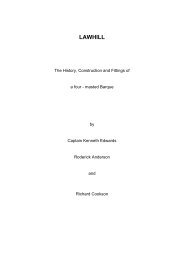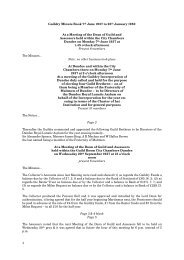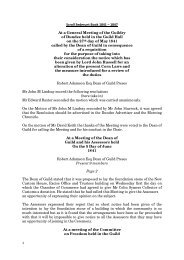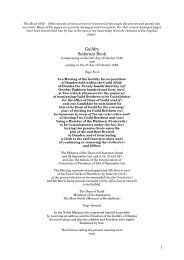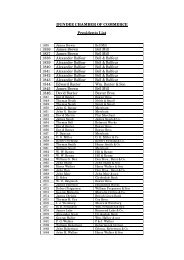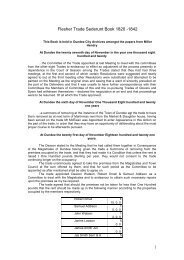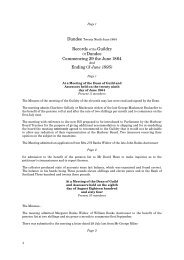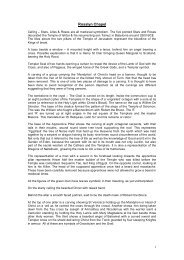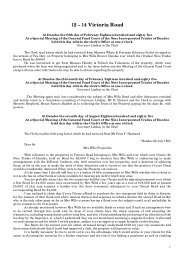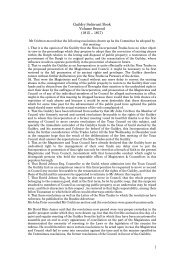Lightholler - Nine Trades of Dundee
Lightholler - Nine Trades of Dundee
Lightholler - Nine Trades of Dundee
Create successful ePaper yourself
Turn your PDF publications into a flip-book with our unique Google optimized e-Paper software.
Second Officer: Charles Herbert Lightoller<br />
Mr. Charles Herbert Lightoller was born in Chorley, Lancashire on 30th March 1874.<br />
In February 1888 at the age <strong>of</strong> 13, he began a four year sea-going apprenticeship making his first trip aboard the<br />
Primrose Hill a steel hulled, four-masted barque <strong>of</strong> 2,500 tons. His next voyage was on the Holt Hill. She was<br />
dismasted in a storm in the South Atlantic, and was forced to put into Rio de Janeiro during a revolution and<br />
smallpox epidemic. After makeshift repairs, she was again dismasted in another storm in the Indian Ocean and on<br />
November 13, 1889 ran aground on St. Paul, an uninhabited, four and a half square mile island in the Indian Ocean.<br />
The Chief Mate was killed in the shipwreck, and after eight days the survivors were rescued by the Coorong and taken<br />
to Adelaide, Australia arriving Christmas 1889.<br />
Lightoller then signed on with the clipper ship Duke <strong>of</strong> Abercorn for his return to England. His third voyage was<br />
aigain on the Primrose Hi!l this time to Calcutta, India On this voyage they survived a cyclone. In Calcutta Lightoller<br />
sat for, and passed his Second Mate's Certificate. While serving as Third Mate on the windjammer Knight <strong>of</strong> St.<br />
Michael the cargo <strong>of</strong> coal caught fire. For his successful efforts in fighting the fire and saving the ship, Lightoller was<br />
promoted to Second Mate.<br />
In 1895 aged 21, already a veteran <strong>of</strong> one shipwreck, a fire at sea and a cyclone Lightoller obtained his Mates ticket.<br />
He left the windjammers and joined Elder Dempster's African Royal Mail Service, starting a career on steamships.<br />
After three years on the West African Coast, he nearly died from a heavy bout <strong>of</strong> malaria.<br />
In 1898, Lightoller left the sea and went to the Yukon to prospect for gold in the Klondike Gold Rush. Unsuccessful in<br />
this quest he had a brief stint as a cowboy in Alberta, Canada. In order to return to home he became a hobo, riding<br />
the rails back across Canada. He worked his passage back as a cattle wrangler on a cattle boat. In 1899, he arrived<br />
back in England penniless. He obtained his Master's Certificate and joined Greenshields and Cowie where he made<br />
another trip on a cattle boat, this time as Third Mate <strong>of</strong> the Knight Companion.<br />
In January 1900, he joined the White Star Line. He first assignment was as Fourth Officer <strong>of</strong> the Medic, a 12,000 ton<br />
passenger-cargo liner on the Britain - South Africa - Australia run. After one voyage, he was switched to the Atlantic<br />
routes for a while. On his next voyage to Australia, again on the Medic, he met Sylvia Hawley-Wilson who was<br />
returning home to Sydney, after a stay in England. On the return passage, she travelled with him as his bride.<br />
Lightoller's early years on the Atlantic run were spent mostly in the Majestic under the command <strong>of</strong> Captain Edward<br />
J. Smith who was to play, a significant part in Lightoller's sea career. From the Majestic he was promoted to Third<br />
Officer on the 17,000-ton Oceanic; known as the "Queen <strong>of</strong> the Seas", she was the pride <strong>of</strong> the White Star Line. In<br />
1907, the home port <strong>of</strong> the Oceanic was changed from Liverpool to Southampton, which meant another move for the<br />
Lightoller fainilly.<br />
From Second Officer on the Oceanic, Lightoller moved up to First on the Majestic and then moved back to the<br />
Oceanic as its First Officer.<br />
Lightoller boarded the Titanic just two weeks before her maiden voyage, and sailed as First Officer for the sea trials.<br />
As sailing day approached, however. Captain Smith made Henry T. Wilde, <strong>of</strong> the Oceanic, his Chief Officer. This<br />
caused the original Chief Officer Murdoch to step down to First, while Lightoller was dropped to Second Officer. The<br />
original Second Officer, David Blair was forced to drop out. The remaining <strong>of</strong>ficers retained their positions.<br />
On sailing day Lightoller and Wilde supervised the departure from their station on the forecastle.<br />
On 14 April, 1912, Second Officer Lightoller carne on duty at 6:00 p.m. His watch would last until 10:00 p.m. that<br />
night. At 7:35 p.m. shortly after his dinner, he noticed how quickly, the temperature was falling now that the sun had<br />
1
set. An hour later the temperature was almost freezing yet the weather was clear and the sea unusually calm. At 8:55<br />
p.m. Captain Smith arrived on the bridge and remarked to Lightoller about how cold it was.<br />
Because <strong>of</strong> the many, stars in the sky. Lightoller believed that there would be a great deal <strong>of</strong> reflected light from any<br />
icebergs that might be nearby. At 9:20 p.m. the Captain left Lightoller with these instructions: “If in the slightest<br />
degree doubtful, let me know." And with that he left the bridge knowing that navigationally speaking, this was the<br />
most crucial part <strong>of</strong> the Titanic's voyage.<br />
Unfortunately, even though the Captain had received a number <strong>of</strong> ice warning messages that afternoon - most<br />
notably from the Baltic, Caronia, Amerika and the Californian - only the Caronia’s warning had been posted in the<br />
chartroom (according to later testimony from the surviving <strong>of</strong>ficers). The <strong>of</strong>ficer's, therefore, were unaware <strong>of</strong> the<br />
other warnings.<br />
At 9:30 p.m. Lightoller instructed Sixth Officer Moody to telephone the crow's nest and ask the men to keep a sharp<br />
lookout for small ice and to pass the word to subsequent watches.<br />
10:00 p.m. Lightoller was relieved by First Officer Murdoch and went through the formalities <strong>of</strong> handing on the<br />
ship's course, speed and revolutions. He let Murdoch know that the lookout had been instructed to lookout for small<br />
ice, he then set <strong>of</strong>f on his rounds, which meant covering a mile or more <strong>of</strong> deck and hundreds <strong>of</strong> feet <strong>of</strong> ladders and<br />
staircases.<br />
He returned to his cabin, and at 11: 40 p.m., was just nodding <strong>of</strong>f when he felt a grinding vibration. Still in his<br />
pyjamas, he went on deck where he met Third Officer Herbert Pitman who had also been disturbed by the vibration.<br />
They concluded that the vessel had hit something, but could see no sign <strong>of</strong> anything. There was no sign <strong>of</strong> undue<br />
alarm on the bridge so they returned to their cabins to await orders.<br />
Ten minutes later, Fourth Officer Boxhall entered his cabin and informed him that "the water was up to the E deck in<br />
the Mail Room." Lightoller pulled a pair <strong>of</strong> trousers, pullover and a bridge coat over his pyjamas and went out on<br />
deck.<br />
The Titanic had been running under full steam, and now every safety valve had been lifted and the steam was roaring<br />
<strong>of</strong>f at all exhausts. Lightoller took charge <strong>of</strong> the even number boats on the port side, but owing to the noise it was<br />
impossible for anyone to be heard. Lightoller found that he had to use hand signals to convey messages. At this time<br />
he was convinced that the situation was serious, but did not believe that the vessel would founder.<br />
As soon as Lightoller received the orders, he started loading women and children into lifeboat 4. When he tried<br />
loading them he found that windows on A-deck were locked, so he switched to loading Lifeboat 6. Suddenly the<br />
safety valves closed and Lightoller found that he was once again able to give orders by Voice.<br />
Wilde seemed unduly, cautious about allowing the boats to be lowered. Lightoller, a veteran <strong>of</strong> a previous shipwreck,<br />
knew differently, and sought the permission <strong>of</strong> the Captain to lower the boats.<br />
He managed to persuade about 25 people to get into lifeboat 6 and started lowering it. About halfway down it was<br />
realized that there was only one seaman in the boat. Lightoller called for a seaman and Major Arthur Peuchan<br />
volunteered that, while not a seaman, he was a yachtsman. Lightoller told him to get onto the falls and slide down to<br />
the boat. This was the only male passenger Lightoller allowed into a lifeboat that night. Among the women helped<br />
into Lifeboat 6 was Margaret Brown.<br />
Lifeboat 8 went away with 24 women, a seaman, two stewards and a cook with orders to row towards the lights <strong>of</strong> the<br />
ship that was still visible but not responding. Boat 12 went away at 1:25 a.m. with 40 women and children. Boat 14<br />
went down the falls at 1:30 a.m. with 50 women and Fifth Officer Lowe. Five minutes later Boat 16 began its descent<br />
packed with women from second class. Around this time Wilde came to Lightoller to ask where the firearms were<br />
kept. These had been Lightoller's responsibility when he had been First Officer in Belfast. ‘Lights’ led Captain Smith,<br />
Wilde and the remaining <strong>of</strong>ficers to the locker in the First Officer's cabin. As he was about to leave Wilde shoved a<br />
gun into his hand with some ammunitions saying you might need this. Lightoller was doubtful but events would<br />
prove Wilde right.<br />
By now, the A-deck windows had been opened and Boat 4 was able to be loaded. Lightoller was aided by US Army<br />
Colonel Archibald Gracie and his friend Clinch Smith. One <strong>of</strong> the passengers in Boat 4 was Madeline Astor. He tried<br />
to remove 13 year old John Borie Ryverson from the boat, but was persuaded by the boy's father to allow him to stay.<br />
Just then someone pointed out that a group <strong>of</strong> men had taken over Lifeboat 2. Lightoller jumped into the boat and<br />
threatened them with his empty, gun driving them all out. With the help <strong>of</strong> Gracie and Smith they were able to load<br />
2
36 women and children into this boat, and it was lowered at 1:55 a.m. The lifeboat needed to travel only 15 feet to<br />
reach the water. In normal circumstances it would have been 70 feet.<br />
At around 2:00 a.m. all <strong>of</strong> the Titanic’s rockets had been fired and all the lifeboats had been lowered save for the four<br />
collapsible Engelhardt-type boats with canvas sides. Collapsibles A and B were still lashed upside down to the ro<strong>of</strong> <strong>of</strong><br />
the <strong>of</strong>ficers' quarters. Collapsible D was lifted, righted and hooked to the tackles where Boat 2 had been. The crew<br />
then formed a ring around the lifeboat and allowed only women to pass through. The boat could hold 47, but after 15<br />
women had been loaded no more women could be found. Lightoller now allowed to men to take the vacant seats.<br />
Then Colonel Gracie arrived with more female passengers and all the men immediately stepped out and made way for<br />
them. When loading this boat, Lightoller was ordered by First Officer Wilde to go with her, "Not damn likely" was<br />
Lightoller's reply and he stepped back on deck. While the collapsible was lowered to the ocean, two men were seen to<br />
jump into it from the rapidly, flooding A deck.<br />
Lightoller still had the Collapsible B to get <strong>of</strong>f. As the water rose on the Boat Deck, he climbed on to the top <strong>of</strong> the<br />
<strong>of</strong>ficer’s quarters and, using a borrowed pen knife he stripped the covers and cut away the ropes. He was able to send<br />
it down to the flooded deck. Just then the Titanic took a great plunge forward. He turned to face the sea and dived in.<br />
He had started to swim clear when he was sucked against the grating <strong>of</strong> one <strong>of</strong> the large ventilator shafts, and he was<br />
taken down with the ship. As the water hit the still hot boilers, the blast blew him back to the surface where he found<br />
himself alongside the capsized Collapsible B. As the Titanic went under, the forward funnel broke loose and toppled<br />
his way, narrowly missing him.<br />
Thirty men had climbed onto the overturned Collapsible B. They included two First Class passengers, Second Officer<br />
Lightoller, Colonel Gracie, the two Marconi Operators Phillips and Bride. The rest were all crew, mainly firemen. They<br />
paddled away from the remaining swimmers, fearing that they would swamp them. Bride informed Lightoller that the<br />
Baltic, Olympic and Carpathia were on their way to rescue them. Lightoller calculated that the Carpathia would arrive<br />
around dawn. Three men died that night, one <strong>of</strong> them Philips.<br />
When dawn and the Carpathia arrived, the Collapsible B was slowly sinking, and as the Carpathia was picking up<br />
other survivors the men on the capsized boat transferred to two lifeboats. Lightoller found himself in lifeboat 12,<br />
designed for 65-capacity, now with 75 persons on board. Boat lifeboat 12 was the last boat to be rescued by the<br />
Carpathia with Second Officer Lightoller in command. As the boat neared the ship, one wave, then another, broke over<br />
its bow. It seemed that she might flounder but was soon in the shelter <strong>of</strong> the Carpathia, rope ladders were lowered and<br />
Lightoller helped all the survivors out before he climbed aboard himself, becoming the last Titanic survivor taken<br />
aboard the Carpathia.<br />
After the Carpathia arrived in New York, Lightoller was called to testify at the American Inquiry into the sinking As<br />
the most senior surviving <strong>of</strong>ficer he found himself having to defend the Captain, the <strong>of</strong>ficers and the company against<br />
some <strong>of</strong> the more serious charges brought against them.<br />
Lightoller with Herbert Pitman at the British Inquiry (Daily Graphic)<br />
In 1913, following the American Senate Inquiry, and the British Inquiry, Lightoller returned to sea as First Officer <strong>of</strong><br />
the Oceanic. On August 4th 1914, the Great War began and the R. M. S. Oceanic became H.M. S. Oceanic, aimed<br />
merchant cruiser, while First Officer Lightoller <strong>of</strong> White Star Lines became Lieutenant Lightoller <strong>of</strong> the Royal Navy.<br />
Oceanic had two captains, a Royal Navy skipper, Captain William Slayter, and Captain Henry Smith, who had been<br />
the commander <strong>of</strong> the Oceanic for the last two years. She was put on Northern Patrol. Her job was to patrol a 150 -<br />
mile stretch <strong>of</strong> water in the area <strong>of</strong> the Shetland Islands. The 17,000 ton, 700ft vessel was far too big and totally<br />
unsuited for the waters in which she was sailing. On September 8th 1914, as a result <strong>of</strong> her unstable command and<br />
unsuitable role, she ran aground on the Shaalds near the island <strong>of</strong> Foula. Lightoller was <strong>of</strong>f watch and in his cabin at<br />
the time. Once again he found himself supervising the lowering and loading <strong>of</strong> lifeboats. Three weeks later the<br />
Oceanic broke up in a storm and was gone.<br />
3
Lightoller's next assignment was to the Campania, a 13,000 ton Cunard liner converted to seaplane carrier. Lights<br />
now found himself as the observer in a Short 184 seaplane. In June 1915, during a Grand Fleet exercise <strong>of</strong>f Iceland, he<br />
was the observer on the only plane able to get into the air. They located the Blue Fleet, and for the first time in<br />
history, a plane sent up by a fleet at sea succeeded in locating an enemy fleet.<br />
Just before Christmas 1915 Lightoller got his own command, the torpedo boat HMTB 17.' During his tour with this<br />
boat, on July 31st 1916, Lightoller attacked the Zeppelin L3 1 with the ships Hotchkiss guns. For his actions Lightoller<br />
was awarded the Distinguished Service Cross and he was also promoted to commander <strong>of</strong> the torpedo-boat-destroyer<br />
Falcon.<br />
On April 1 st 1918, Lightoller was again <strong>of</strong>f watch, lying in his bunk, when the Falcon collided with the trawler John<br />
Fitzgerald. She stayed afloat for a few hours, eventually sinking just about same time, six years to the day as the<br />
Titanic sinking.<br />
Lightoller was now given a new command, the destroyer Garry. On July 19th 1918, they rammed and sank the<br />
German submarine LTB- 110. The ramming, damaged the bows <strong>of</strong> the Garry so badly that she had to steam 100<br />
miles in reverse to relieve the strain on the forward bulk-heads as she returned to port for repairs. For this action<br />
Lightoller was awarded a bar to his DSC and promoted to Lieutenant-Commander.<br />
At the end <strong>of</strong> 1918, Lightoller came out <strong>of</strong> the Royal Navy as a full Commander. On his return to White Star he was<br />
appointed Chief Officer <strong>of</strong> the Celtic having been passed over for a position on the Olympic, the new management<br />
wanted to forget the Titanic and all those associated with her. None <strong>of</strong> the surviving <strong>of</strong>ficers from the Titanic ever got<br />
their own commands. Lightoller was not interested in remaining Chief Officer <strong>of</strong> the Celtic indefinitely, so, after well<br />
over 20 years <strong>of</strong> service Lightoller resigned from White Star Line.<br />
As these were the depression Years, the first few years were hard. The Lightollers opened a guest house and after a<br />
few years had some minor success in property speculation.<br />
In 1929, the Lightollers had purchased a discarded Admiralty steam launch, built in 1912 by G. Cooper at Conyer. She<br />
was 52 feet long by 12,2 feet wide, powered by a petrol-paraffin Parsons 60 hp. Commander Lightoller had her<br />
refitted and lengthened to 58 feet, converting her into a 62hp Glennifer diesel motor yacht that was christened<br />
Sundowner by Sylvia. Throughout the thirties she was used by the Lightoller family mainly for trips around England<br />
and Europe. In July, 1939, Lightoller was approached by the Royal Navy and asked to perform a survey <strong>of</strong> the<br />
German coastline. This they did under the guise <strong>of</strong> an elderly couple on vacation in their yacht. When World War II<br />
started in September 1939, the Lightollers were raising chickens in Hertfordshire. The Sundowner was kept in a<br />
yacht basin at Chiswick.<br />
Then in the closing days <strong>of</strong> Mav 1940, after eight months <strong>of</strong> quiet known as the "phony war", Britain found itself on<br />
the edge <strong>of</strong> military disaster. The German armies blitzkrieged through Holland, Belgium, Luxembourg and Northern<br />
France in just over two weeks. Allied resistance had disintegrated and almost the entire British Expeditionary Force<br />
(BEF) was penned into a tiny pocket on the French Belgian border.<br />
On May 24th 1940, some 400,000 Allied troops lay pinned against the coast <strong>of</strong> Flanders near the French port <strong>of</strong><br />
Dunkirk. German tanks were only ten miles away. Yet the trapped army was saved. In the next 11 days over 338, 000<br />
men were evacuated safely to England in Operation Dynamo, one <strong>of</strong> the greatest rescues <strong>of</strong> all time.<br />
At 5 p.m. on May 31st 1940, Lightoller got a phone call from the Admiralty asking him to take the Sundowner to<br />
Ramsgate, where a Navy crew would take over and sail her to Dunkirk. Lightoller informed them that nobody would<br />
take the Sundowner to Dunkirk but him.<br />
On the 1st <strong>of</strong> June 1940, the 66 year old Lightoller, accompanied by his eldest son Roger and an 18 year old Sea-Scout<br />
named Gerald, took the Sundowner and sailed for Dunkirk and the trapped BEF. Although the Sundowner had never<br />
carried more than 21 persons before, they succeeded in carrying a total <strong>of</strong> 130 men from the beaches <strong>of</strong> Dunkirk. In<br />
addition to the three crew members, there were two crew members who had been rescued from another small boat,<br />
the motor cruiser Westerly. There were another three Naval Ratings also rescued from waters <strong>of</strong>f Dunkirk, plus 122<br />
troops taken from the destroyer Worchester. Despite numerous bombing and strafing runs by Luftwaffe aircraft, they<br />
all arrived safely back to Ramsgate just about 12 hours after they had departed. It is said that when one <strong>of</strong> the soldiers<br />
heard that the captain had been on the Titanic, he was tempted to jump overboard. However his mate was quick to<br />
reply that if Lightoller could survive the Titanic, he could survive anything and that was all the more reason to stay.<br />
Following Dunkirk, Commander Lightoller Joined the Home Guard, but the Royal Navy engaged him to work with<br />
the Small Vessel Pool until the end <strong>of</strong> World War H. The Lightollers youngest son, Brian, was in the RAF as a pilot.<br />
On the first night <strong>of</strong> World War II, he was killed in a bombing raid on Wilhelmshaven. Their eldest son, Roger, went<br />
4
on to join the Royal Navy where he commanded Motor Gun Boats. During the final months <strong>of</strong> the war, he was killed<br />
during a German Commando raid on Granville on the North French Coast.<br />
Lightoller was 'demobbed' in 1946 at age 72. He went on to run a boatyard called Richmond Slipways, building<br />
motor launches for the London River Police.<br />
On December 8th, 1952, Charles Herbert Lightoller passed away. He was cremated at Mortlake Crematorium and<br />
the ashes scattered in the Garden <strong>of</strong> Remembrance.<br />
5



